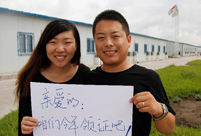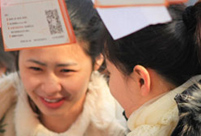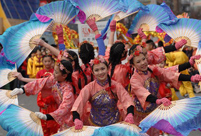 Turnip sculptures amaze tourists in Qingdao
Turnip sculptures amaze tourists in Qingdao Chinese ship formation conducts live fire training in West Pacific
Chinese ship formation conducts live fire training in West Pacific
 China comes in third at figure skating team event
China comes in third at figure skating team event
 China's teenager skater Yan shines at his Olympic debut
China's teenager skater Yan shines at his Olympic debut
 Taiwan-born actor stars on US TV series
Taiwan-born actor stars on US TV series
 Chinese Lunar New Year gift from abroad
Chinese Lunar New Year gift from abroad Chinese champions of Winter Olympic Games
Chinese champions of Winter Olympic Games  Zhang Yimou fined 7.48 mln for over-production
Zhang Yimou fined 7.48 mln for over-production
 Top 10 timeless female Chinese stars
Top 10 timeless female Chinese stars
Rome, February 4 - Masterpieces by Italian-Swiss sculptor and painter Alberto Giacometti (1901-1966) will feature in an exhibit at Rome's Galleria Borghese opening on Wednesday and continuing through May 25.
Bronzes by Giacometti, whose doubt-infused work fascinated contemporary writers and artists ranging from Jean-Paul Sartre to Pablo Picasso, will be shown alongside the Borghese Gallery's permanent collection embracing Neoclassical sculptures like Antonio Canova's Paolina and Gian Lorenzo Bernini's Baroque Apollo and Daphne as well as ancient Roman-Greek and Egyptian statues.
"Giacometti: La scultura" was organized by the director of the Roman museum Anna Coliva, and by Christian Klemm, one of the leading experts on Giacometti and the author of a number of monographs on the artist, who selected the 40 works of art and studied their collocation beside the Villa's extraordinary collection.
Giacometti earned a reputation in the early 1930s in Paris through his erotic and ironic Surrealist figures.
After rejecting Surrealism, during and after the Second World War, he started creating his stunning pole-like human bodies widely perceived as metaphors for post-war trauma and doubt.
The elusive charisma of Giacometti's work has influenced a range of contemporary sculptors from David Smith to Mark di Suvero, embodying a century of great political, historic and cultural turmoil.
The tragic emphasis and poetry of his art is enhanced in the exhibit by its juxtaposition with the permanent Borghese collection, ranging from ancient Roman to Baroque sculptures, including Bernini's powerful David.
The sensual shape of Giacometti's Femme couchée qui reve (1929) can be admired alongside Canova's Paolina, whose gaze stares towards the Tete qui regarde (1929), another early work by Giacometti.
Visitors can imagine the heavy steps of Giacometti's Homme qui marche (1947) and of Bernini's Aeneas as he makes arduous progress while carrying Anchises.
The unstable balance of Homme qui chavire (1950) can be compared to David's, also by Bernini, while the mysterious, dark Femme qui marche (1932-1936) is on display in the equally breath-taking Egyptian room.
Indeed, the artist's flattened heads and stark profiles are often reminiscent of ancient Egyptian figures.
The 40 Giacometti works of art on display are a voyage through his art's burning energy as he investigates the vital depth of men and women by reducing the human body to its essence.
Born in the Bergell Valley in Italian-speaking Switzerland in 1901, Giacometti moved to Paris in 1922, when the art scene was vibrant and wide open. Paris was his home until his death in 1966, aged 64.
His Surrealist works in the 1930s are at once elegant and perverse. Sculptures like the Disagreable Objects are at once aggressive and innocent, a reflection of the Surrealist preoccupation with sexuality.
Giacometti's women are objects of desire yet dangerous while the artist is also attracted to androgyny for its duality - a metaphor for the totality of life.
In the exhibit, the tragic awareness of the potential failures and frailty of mankind portrayed by Giacometti emerges in stark contrast to the human greatness glorified by the Borghese permanent collection.
The exhibit starts with the artist's late works including Grand Femme Debout I (1960) and Homme qui marche I (1960) and continues with the artist's 1920s works in the Canova room, including Femme couchée qui reve (1929), Femme chouchée (1929) and Homme (Apollon) (1929).
The Hermaphrodite Room hosts, among others, Femme Egorgée (1932) while Portrait de Madina Visconti (1932) and Tete d'Annette (1959) can be admired in the Vestibule.
The show ends in the Lanfranco Room with Giacometti's most celebrated busts including his wife's Annette as, by the mid-1950s, the artist increasingly focused on portraiture, sculpting his family and immediate circle of friends, to masterfully convey the psychological intensity of the human face.
 Special Coverage: Sochi Winter Olympic Games
Special Coverage: Sochi Winter Olympic Games  A day of a female high-speed train chief attendant
A day of a female high-speed train chief attendant New Year greetings from Chinese nationals in Africa
New Year greetings from Chinese nationals in Africa PLA navy conducts landing drills in South China Sea
PLA navy conducts landing drills in South China Sea  Blind date fair in Hangzhou
Blind date fair in Hangzhou  Highlights of Chinese New Year celebrations around the world
Highlights of Chinese New Year celebrations around the world  How do the Chinese spend their money during Spring Festival?
How do the Chinese spend their money during Spring Festival? 'Milk Tea' girl hosts Spring Festival gala of universities in U.S.
'Milk Tea' girl hosts Spring Festival gala of universities in U.S.  Brave mother fights cancer, enjoys Spring Festival with her triplets
Brave mother fights cancer, enjoys Spring Festival with her triplets President Xi attends opening ceremony of Sochi Winter Olympics
President Xi attends opening ceremony of Sochi Winter Olympics Highlights of opening ceremony of Sochi Winter Olympic Games
Highlights of opening ceremony of Sochi Winter Olympic Games Snowscape in Chinese New Year
Snowscape in Chinese New Year Interesting horse figures in life
Interesting horse figures in life  Top 20 most beautiful Chinese stars
Top 20 most beautiful Chinese stars  Top 10 Chinese films in 2013
Top 10 Chinese films in 2013Day|Week|Month